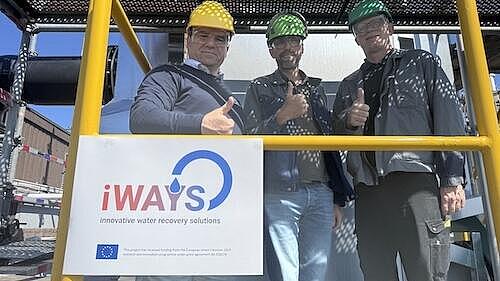 Search Result
Search ResultInnovative system recovers heat, water and material from industrial waste streams
We are excited to announce that the first innovative Heat Pipe Condensing Economiser (HPCE) has been commissioned at our project partner Alufluor AB in Sweden and is running. The aluminium fluoride…
Read Full article
Davide Casarin
I am an Associate Project Manager and a former student of the Post-graduate Master in European Studies in Brussels. My research interests range from macroeconomics and public policy to security studies. At the Graduate School of Public and…
Author details
Andreas Lindinger
Andreas Lindinger is Senior Consultant in Decarbonisation and Urban Management at Denkstatt. He has a transdisciplinary sustainability, finance and business background and broad international and consulting experience. Andreas works on sustainability…
Author details
Abe Scholte
Kryha is a leading distributed technologies studio that specializes in the design and development of enterprise digital ecosystems to enable sustainable industry transformation. Our strength lies in realizing valuable blockchain systems in complex…
Author details
Christian Ecker
Christian Ecker is a Project Manager with Minespider. He focuses on the implementation of traceability processes and sustainability policies, with a particular interest in local-level human rights & environmental impacts. He holds a Master's in…
Author detailsICP Presentation 2019 (GER)
Das Investor Confidence Project Europe eröffnet den Zugang zu Finanzierungen für den Gebäude-, Industrie-, Energie- und Straßenbeleuchtungsmarkt, indem es standardisiert, wie Energieeffizienzprojekte entwickelt, dokumentiert und gemessen werden. Für weitere Informationen über die Verwendung von ICP-Protokollen, Schulung und Verifizierung klicken Sie bitte hier .
Read Full Business PracticeICP Presentation 2019 (AT)
Das Investor Confidence Project Europe eröffnet den Zugang zu Finanzierungen für den Gebäude-, Industrie-, Energie- und Straßenbeleuchtungsmarkt, indem es standardisiert, wie Energieeffizienzprojekte entwickelt, dokumentiert und gemessen werden. Für weitere Informationen über die Verwendung von ICP-Protokollen, Schulung und Verifizierung klicken Sie bitte hier .
Read Full Business PracticeStart-up BATINEW: concept for a neighbourhood infrastructure
Short description of start-up BATINEW concept for a neighbourhood infrastructure which functions in symbiosis with different technologies and takes advantage of all available resources (solar power, organic waste, waste heat, waste water, etc.). Find out more about their innovative upcoming projects at the world’s leading trade fair Hannover Messe 2016. Visit Batinew at hall 2, stand C39
Read Full Business PracticeEnergy Management for logistic provider
Pošta Slovenije (Slovenian Post Office) - the primary and largest provider of the postal and associated logistics services in Slovenia has joined efforts with Solvera Lynx to introduce ISO 50001 Standard for Energy management and increase energy efficiency at more than 350 postal facilities in the total area of more than 150.000 sq. m. The project also included the car fleet (1.300 vehicles).
Read Full Business PracticeEnergy Efficient Europe
A 1 day event from Cefic and the SPICE3 project on ENERGY EFFICIENT EUROPE, focusing on the chemical industry. The event aims to look at Industrial Energy Efficiency from the perspective of the different stakeholders, namely the EU Parliament EU…
Details